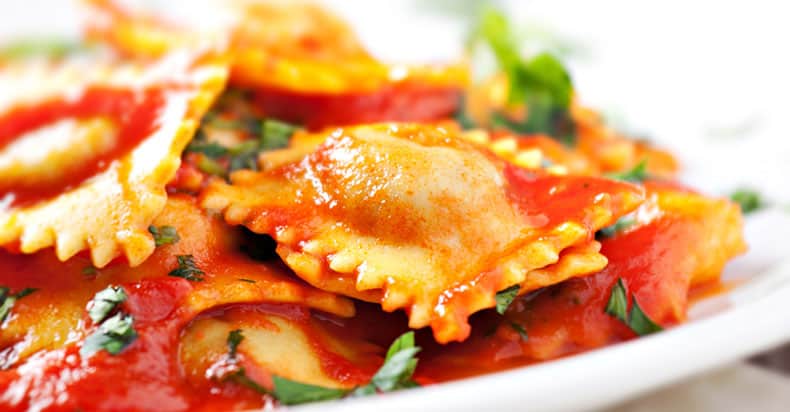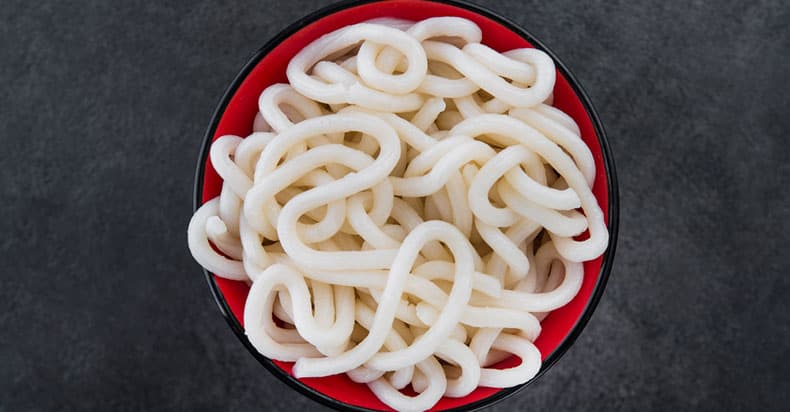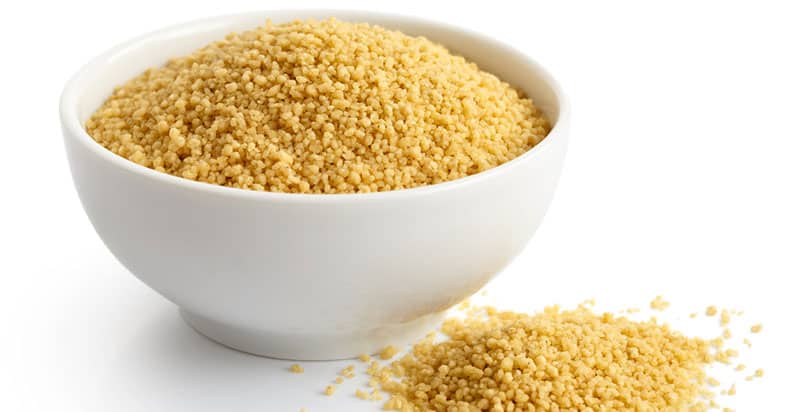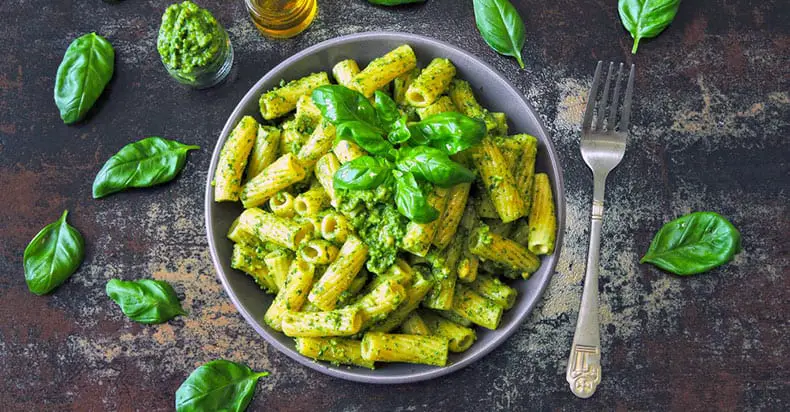The term “pasta” is used to refer to a wide number of foods, from the pasta itself (the wheat portion) to specific recipes that pasta tends to be incorporated in (spaghetti, etc.). Today we’ll be looking at whether pasta, in general, is considered vegan.
We’ll also examine which pasta varieties and pasta-containing recipes tend to contain animal products so you’ll know what to look out for.
Is it vegan? Most pasta is considered vegan. Pasta, meaning “dough” or “paste” in Italian, is composed predominantly of water and wheat starch. The wheat is either flour that’s extruded or stamped to form various shapes, or simply the wheat middlings (e.g. couscous). So, the two most common ingredients are vegan.
What we’ll do here is look at the various vegan and non-vegan forms pasta can take.
Non-Vegan Ingredients Common in Pasta
Of course, there are non-vegan pasta varieties, and any pasta type can be used in non-vegan preparations. When stamped or extruded, the wheat flour is used to make pasta like macaroni, lasagna, spaghetti, vermicelli, and noodles.1 Most contain the same core ingredients, which we’ll touch on here.
Egg Yolk
Egg yolk is a possible, yet unlikely ingredient in commercial pasta.
In the past it was more common, especially in certain types of noodles. In the case of noodles, the flour (usually semolina) was combined with egg yolk to impart a desirable yellow color, though other colorings are also common.2
Today, the ingredient is used much less often than most realize. Egg yolk was used to impart a nice golden color, and pasta manufacturers can use a variety of other methods to achieve this effect.
For example, quality pasta is made from wheat having a higher protein content. Durum flour is a favorite for this reason. The higher protein content in durum wheat makes it well-suited to handling the high heat and pressures of mechanical manipulation (i.e. kneading) during commercial pasta production.3
The protein also gives pasta its elasticity and allows it to maintain its shape during cooking.
Anyway, durum wheat is high in carotenoid pigments—the rich golden, yellow, and orange pigments abundant in plant foods which contributes to pasta’s rich, golden color.4
While egg is less frequently encountered in commercial pasta today, it’s still out there.
We’ll touch on this more below, but the presence of egg is what set noodles apart from other types of pasta over the years. The texture of noodles, aka “egg pasta”, is stronger compared to other pasta varieties and the mouth-feel is somewhat different.5
The presence of egg yolk also alters the nutritional profile of the pasta, allowing manufacturers to charge more.5
What About Additives?
Other ingredients common in pasta tend to be vegan-friendly. For example, in North America, most pasta is enriched with micronutrients like iron and B vitamins.
With the exception of vitamin D (not present in pasta) micronutrients tend to be derived from vegan-friendly sources—usually synthesized or produced microbially.
I’ve seen certain plant-based gums used in pasta before—guar gum and xanthan come to mind. Both ingredients are considered vegan.6
If a non-wheat flour is used (chickpea flour), sometimes protein will be added, but I’ve never seen an animal-based protein used in pasta—it’s always pea or soy protein.
Non-Vegan Applications of Pasta (Dishes, Recipes)
If you see pasta on the menu at a restaurant, you can almost be certain that non-vegan ingredients will accompany the dish—from meat to cheese, to non-vegan dressings.
Meat-Containing Pasta: Spaghetti, Ravioli

No matter how vegan-friendly a pasta noodle is, it can’t be consumed if it’s topped or stuffed with meat. Unfortunately, such is the case with spaghetti and ravioli.
Just assume they’re non-vegan unless specified otherwise. A lot of vegetable lasagna is vegetarian-friendly, yet unsuitable for vegans due to the presence of cheese.
A quick internet search should render countless vegan spaghetti, lasagna, and ravioli recipes and specialized products. But, by default, these are always considered non-vegan unless marketed to vegans.
Cheese-Containing Pasta: Mac and Cheese, Lasagna
It may not be obvious to a lot of folks that cheese would render a pasta dish off-limits for vegans. This is true especially for newcomers to the diet and those researching vegan diets for the first time.
Don’t get me wrong, there are plenty of vegan “cheese” products on the market, and specialty products like vegan mac and cheese, vegetable lasagna, etc. so exist.
But pasta preparations like macaroni and cheese and lasagna should always be assumed to be non-vegan unless labeled otherwise.
Italian Pasta
This pasta is usually made using fusilli noodles (the colorful twisty kind), with Italian dressing, black olives, etc.
In some regions, this type can be referred to simply as “pasta” and it can usually be found in buffets and salad bars here in the US.
While the most basic version of this stuff is vegan, it does tend to contain cheese. So, unless stated otherwise, it’s best to assume this variety is non-vegan. Keep in mind that the cheese may not be easy to spot—it’s often grated parmesan.
Vegan-Friendly Pasta and Noodle Varieties
Udon Noodles Is Vegan

Above it was mentioned that noodles can often pose problems for vegans, as the traditional recipe for noodles in the past contained egg yolks.
However, udon noodles are an exception. This type of noodle has traditionally been made using only water and wheat. Used frequently in Japanese, Korean, and Palauan cuisine, the udon noodle is a thick pasta.7
While it’s common in Asian dishes like hot and sour soup, this noodle can be used in a variety of recipes.
Interestingly, the presence of egg is what has been thought of as what differentiates noodles from pasta in general. For this reason, udon noodles, in the West, were often called imitation noodles.8
Noodles, in general, have typically been prepared by making “alimentary paste,” combining water with flour (semolina flour and/or farina, etc.).
Eggs are then added at 5.5% or more by weight, the at which point the pasta is referred to as noodles.8
But for some odd reason, there are eggless pasta varieties on the market that are referred to as noodles, despite being eggless, and udon noodles are one such type.8
Asian noodles also differ in that they are typically prepared using wheat flours other than semolina or farina and they are often translucent or clear in appearance.9
Because they are supposed to be translucent in appearance, egg yolk isn’t needed to achieve a golden texture, which is good news for vegans.
Keep in mind that while udon noodles tend to be vegan, like all processed food products, they can contain egg. So, you’ll always want to scan the label to make sure.
Spaghetti And Lasagna Noodles Are Vegan
Earlier it was mentioned that lasagna and spaghetti are typically off- limits to vegans. Well, that goes for the actual Italian dishes. The noodles themselves tend to be vegan—at least, in my experience scouring endless ingredient labels.
In other words, pasta marketed as spaghetti and lasagna noodles wouldn’t really be considered noodles in the original sense of the term.
Rather, most are made with just water, semolina flour, additives, and vitamins, and minerals.
Gnocchi Is Vegan
This goes for the wheat pasta itself, not for the various dishes it tends to be used in. Gnocchi is a type of pasta composed of soft, small, yet thick dumplings made of potato, semolina or ordinary wheat flour, though other flour can be used like cornmeal or even breadcrumbs.10
Herbs, vegetables, flavorings, and other ingredients are often added depending on the variation.11-14
Again, beware of dishes made with gnocchi as most contain animal products, especially egg and dairy. If purchasing a pre-made gnocci dish, keep a lookout for cheese, butter, eggs, and beef gravy.
Couscous Is Vegan

I wrote an entire article on the vegan status of couscous, where I cover more in depth the ingredients you’ll want to look out for.
Couscous is considered pasta because it is middlings of durum wheat (the type of wheat used to make most pasta) and because the middlings become gelatinized when heated with water imparting a pasta-like texture.
It’s a food product that most think of as just another type of grain (like quinoa, rice, etc.). But it is technically considered pasta so I’m listing it here. The grain-like food product is referred to often as “Moroccan pasta”.
Couscous, originally a Maghrebi dish, is becoming more and more popular these days in regions like North America and Europe.
So you know, couscous refers to small (~0.12 in or 3 mm) steamed pieces of pulverized durum wheat semolina. Though, in some regions of the world, couscous is often larger, resembling small balls.
In Europe and North America, couscous is made from semolina that’s been dried, crushed into small rice-like particles and then cooked.8
Anyway, couscous is a great option if you’re looking for a minimally processed vegan-friendly pasta that’s also a good source of fiber, protein, and other nutrients like phosphorus.
Is Pasta Vegan? Conclusion
That’s it for the vegan status of pasta. Just know that pasta itself is typically vegan, but the majority of pasta dishes are non-vegan.
Noodles, a type of pasta traditionally processed using yolk, tends to be egg-free these days. So, most commercial spaghetti and lasagna noodles are vegan-friendly.
Ordering pasta at non-vegan restaurants should probably be considered impractical for the most part. While you could find out easily if the noodles are free of egg ingredients (asking the waiter or looking online), most pasta dishes prepared at restaurants are going to contain meat or dairy in one form or another, especially cheese.
There are tons of vegan specialty products on the market like meatless spaghetti, vegetable lasagna, and even vegan ravioli (usually with mushroom or olives in the center). If you prefer to cook, recipes for these dishes can be easily found with a quick search online.
That wraps it up.
As always, thanks for reading.
References
- Gallagher E. Formulation and nutritional aspects of gluten-free cereal products and infant foods. In EK Arendt and F Dal Bello. Gluten- Free Cereal Products and Beverages. Academic Press, 2008.
- Boyacioglu MH, and BL D’Appolonia. Durum wheat and bread products. Cereal Foods World 39(3):168–174, 1994.
- Mariani BM, MG D’egidio, and P Novaro. Durum wheat quality evaluation: Infl uence of genotype and environment. Cereal Chemistry 72(2):194–197, 1995.
- Cole ME, DE Johnson, and MB Stone. Color of pregelatinized pasta as infl uenced by wheat type and selected additives. Journal of Food Science 56(2):488–493, 1991.
- Pasta and Semolina Technology (Page 177). R. Kill-Keith Turnbull – Blackwell Science – 2001. ISBN 0-632-05349-6.
- Xanthan Gum Is Vegan – No Egg Whites. https://www.vrg.org/blog/2018/06/28/xanthan-gum-is-vegan-no-egg-whites/
- Udon. https://en.wikipedia.org/wiki/Udon
- Understanding Food: Principles and Preparation (Page 359). Amy Brown – Wadsworth Cengage Learning – 2011. ISBN-10: 0-538-73498-1
- Chansri R, C Puttanlek, V Rungsadthong, and D Uttapap. Characteristics of clear noodles prepared from edible canna starches. Journal of Food Science 70(5):S337– S342, 2005.
- What Is Gnocchi? https://www.allrecipes.com/article/what-is-gnocchi/
- Riley, Gillian (2007-11-01). The Oxford Companion to Italian Food. Oxford University Press, USA. ISBN: 9780198606178.
- Waverley Root. https://en.wikipedia.org/wiki/Waverley_Root
- Luigi Carnacina, Luigi Veronelli, La cucina rustica regionale (4 vol.), Rizzoli 1966, passim. ASIN: B00D5EDSFM
- Accademia Italiana della Cucina, La Cucina: The Regional Cooking of Italy, tr. Jay Hyams, Rizzoli, 2009, passim. ISBN-10: 0847831477

